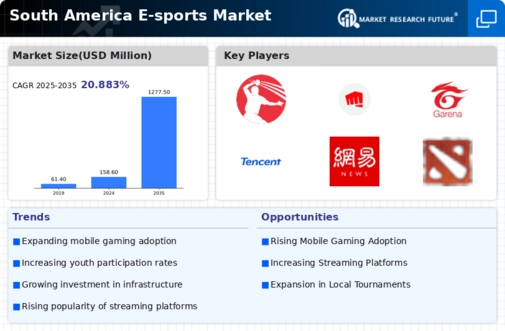The South America E-sports Market has been experiencing significant growth in recent years, driven by an increase in internet accessibility, a growing youth demographic, and an increasing cultural acceptance of gaming as a legitimate form of entertainment.
E-sports tournaments and competitive gaming events are gaining popularity across various countries in the region, creating a competitive landscape that attracts both local and international attention. With numerous titles gaining traction, gamers and teams are emerging as key players, leading to sponsorship opportunities, investments, and the development of professional leagues.The interplay between local talent and global gaming trends is reshaping how the market functions, providing new avenues for engagement and monetization.
Challenger Series has established itself as a prominent player in the South America E-sports Market, cultivating local talent and fostering competitive gaming through structured leagues and tournaments. The series is geared towards aspiring professional players, offering a platform that bridges the gap between casual gaming and professional E-sports.
This initiative enhances community involvement and promotes grassroots-level engagement, allowing players from diverse backgrounds to showcase their skills on a recognized stage. Additionally, the Challenger Series strengthens the E-sports ecosystem in South America by creating a robust recruitment pipeline for professional teams and ensuring continuous growth in player skill levels.The localized approach and focus on nurturing emerging talent have positioned the Challenger Series as a vital contributor to the regional E-sports landscape.
Riot Games is another influential force in the South America E-sports Market, particularly known for its flagship title that has gained a massive following across the region. The company has implemented strategic initiatives to enhance its presence in South America, including local servers, community outreach programs, and localization efforts tailored to the region's unique cultures.
Riot Games offers competitive E-sports events, including annual tournaments that attract both viewers and players alike, thereby stimulating interest and participation in E-sports. With a commitment to fostering community engagement, Riot Games emphasizes inclusivity and accessibility in its services, bolstering its reputation in the South American gaming community.
The company actively pursues partnerships and collaborations that facilitate growth, including targeted sponsorships and participation in local events. These efforts not only strengthen their market position but also enhance the overall gaming experience for players and fans alike, solidifying Riot Games' role as a catalyst in the development of E-sports in South America.























Leave a Comment